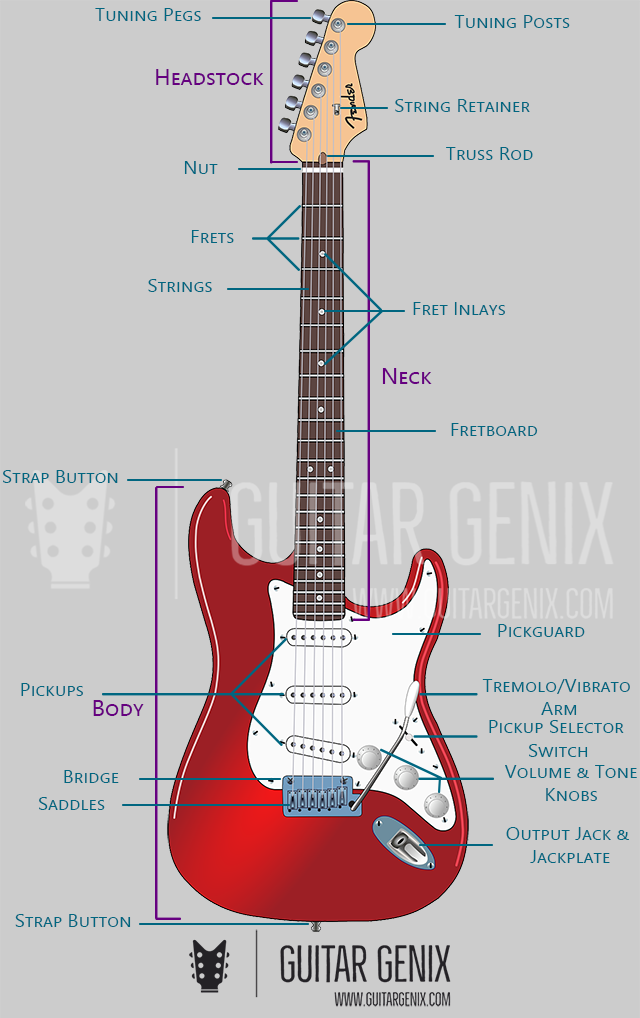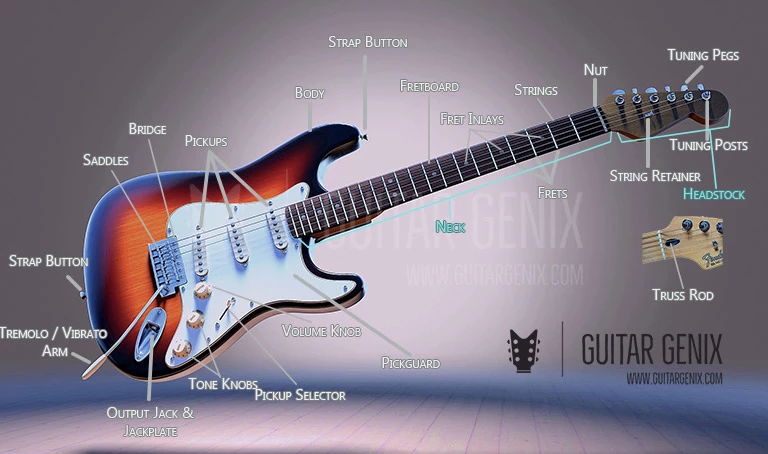Electric guitars are one of the world’s most popular and versatile musical instruments. More complicated in both looks and working than standard acoustic guitars, electric guitars are the hearts of some of the most energy-filled genres. There is nothing like going to a live performance and seeing and hearing the guitarist do a cool solo! If you’re fascinated by electric guitars or just bought a new one and want to know the different parts of the electric guitar and their functions, then this article is for you.
This article will discuss and explain the different sections and parts of a standard electric guitar. There are 22 parts in an electric guitar (many common electric guitars may have fewer parts), so this article will be pretty long but informative. Let’s start with a labeled diagram, so it is easy for you to understand which part is which.

Different Sections of an Electric Guitar
An electric guitar can be divided into three sections – the body, the neck, and the headstock. Every electric guitar will have these three sections, although their shape and size may vary between different models and manufacturers.
Guitar Body
The guitar’s body contains all the guitar’s electronic components, such as the pickups, the volume and tone controls, and various other electronics, including a preamp in case of an active electric guitar.
The body is typically made of hardwoods such as alder, mahogany, or maple but can be made of other hardwoods. The wood type affects the tone of the guitar as well. The wooden body is colored and lacquered to make it shiny and more attractive looking.
Most electric guitars are solid-body, but semi-hollow and fully-hollow guitars also exist. As the name suggests, a semi-hollow has a sound chamber, albeit much smaller than an acoustic guitar, and a full-hollow may have a bigger chamber but much smaller than an acoustic guitar.
Guitar Neck
The neck extends from the guitar’s body and primarily consists of the fretboard. Made of solid wood, the neck is separate from the body and is usually bolted to it firmly.
The neck of the guitar has one of the most crucial parts inside – the truss rod, which stabilizes the neck from the tight pull of the strings by providing counter tension.
Headstock
The headstock or the head of the guitar contains the machine heads or the tuners. Many guitars (like the one in the picture) have a straight headstock when viewed from the side, and it is part of one whole wooden piece which makes the neck. Some guitars may have an angled headstock, in which case a separate piece of wood is glued to the neck.
The tuners in the headstock may be 6-in-line (like in the picture) which is popular among Fender’s electric guitar lineup, or 3+3, where three tuning pegs are on each side.
Besides this, headstocks almost always have the manufacturer’s name and branding, making them one of an electric guitar’s most important aesthetic elements.
Different Parts of an Electric Guitar
With the main sections out of the way, let’s now on the various parts of an electric guitar and what they do.
Tuning Pegs and Tuning Posts
The machine heads consist of the tuning pegs and the tuning posts with a gear mechanism connecting these two parts. The pegs can be turned clockwise or counter-clockwise, and it rotates the tuning posts with a hole to which the strings attach.
The rotation adjusts the tension of the strings and is used to set the strings in the tuning the guitarist wants. Different brands have different tuner arrangements. Some may have all six tuners on one side, while some have three on one side and three on the other. Irrespective of the arrangement, they work the same way.
String Retainer
Also known as string trees, these are usually found on guitars with a straight headstock like in Fender guitars. Their purpose is to prevent the string from coming out of the nut’s slot because of the straight angle of the headstock.
There can be one or two string retainers, depending on the model.
Nut
The nut can be made of bone, plastic or, very rarely, metal and have slots or grooves on which the strings sit. They are a small but vital part of the guitar. They decide the strings’ height above the fretboard (called string action).
An improper nut may add buzzing to the sound or cause intonation issues. It is not adjustable by the user and should be left untouched for the most part.
The only time you’ll need nut adjustment is when you’re trying to restring the guitar with much heavier gauge strings that do not fit the slots. In such scenarios, the help of an experienced luthier may be sought.
Strings
A standard electric guitar has six strings tuned to E – A – D – G – B – E from the thinnest to the thickest. The strings are made of electromagnetic materials like steel, and the pickups convert their vibration into an electrical signal, which is then amplified to produce the sound output. The strings can be made of different materials, have different physical structures and with different coatings.
A set of 6 strings has different thicknesses for each string responsible for producing different pitches. Similarly, string sets of different gauges are also available. Thinner sets have a brighter, treble-rich sound, while thicker strings have a more rounded, bass-rich tone. Different materials also affect the tone.
Frets
Frets are strips usually made of metal inserted on the fretboard and fixed with glue to keep them in place. When a string is pressed onto a particular fret, the length of the string’s vibrating part changes which subsequently changes the pitch produced.
The spacing of the frets on the fretboard depends on the guitar’s scale length, which in turn depends on the length of the neck. Frets may need replacement after some time (usually several weeks to a few months of aggressive playing) when they wear out.
Fret Inlays
Fret inlays or markers are small dots on the fretboard, usually utilized to mark certain frets and for decorative purposes. A typical guitar may have single dot inlays on the 3rd, 5th, 7th, 9th, double inlays on the 12th, and then again single ones on the 17th, 19th and 21st frets. Gibson guitars usually have much bigger, trapezoid-shaped inlays.
These inlays usually have a contrasting color with the fretboard to be easily visible. Guitarists may use them as a guide to locate the frets, especially further down the fretboard quickly. Many guitars also have small dots on the side of the neck facing the player, whch are instead used as a guide. In this case, the fretboard inlays are primarily for decorative purposes.
Fretboard
Also known as the fingerboard, it is usually made of a thin wooden sheet glued on top of the neck of the guitar. Some guitars may not have a separate fretboard; instead, the neck material is used as the fretboard.
Fretboards are one of the essential parts of the guitar on which the frets are laid out. It is necessary to take care of the fretboard by cleaning them frequently as they are in constant contact with our fingers.
Strap Button
The guitar straps are attached to these buttons, and the strap is worn over the shoulder so that both hands are relatively free to maneuver. Electric guitars are heavy instruments, and straps allow freeing up your arms and even prevent the guitars from an accidental fall.
Generally, wider straps are more comfortable, and you should adjust the length so that the guitar hangs at a height that is the most comfortable for you to fret and strum without straining.
Pickups
Pickups can be thought of as the heart of electric guitars because these are what convert the strings’ vibrations into signals. Many types and variations of pickups are available, but most electric guitars have electromagnetic pickups.
Most of the guitars have either 2 or 3 pickups. The one closest to the bridge is called the bridge pickup, the one in the middle is called the middle pickup, and the last one nearest to the neck is called the neck pickup.
A typical guitar will let you select the pickup(s) you wish to get the signal from. Selecting different pickups or a combination of them will affect the tone of your sound output.
Bridge
The strings attach to the tuners on one side and the bridge on the other side of the guitar. The bridge plays a major role in electric guitars, as an improperly adjusted bridge can ruin your tone. Most electrical guitar bridges have a mechanism for fine-tuning the strings’ intonation and action (height).
Some bridges (like the one shown in the picture) may have a detachable arm known as the tremolo arm, which makes advanced effects like vibrato possible.
A bridge can affect a guitar’s intonation, action, sustain and tuning stability. A good quality, adequately adjusted bridge is thus essential in producing optimal sound output.
Saddles
Saddles are part of a bridge to which the individual strings are anchored. Most electric guitar bridges have an adjustable saddle that has screws on the side to set the intonation. Some higher-end bridges may also have height adjustments for individual saddles, which can be used to set the action of the individual strings.
Tremolo/Vibrato Arm
Some guitars have a special bridge with a detachable “arm” called the tremolo, vibrato or whammy arm. In simple terms, these bridges have a separate spring-loaded structure that holds the saddles and can be moved back and forth by the bar. This temporarily changes the tension of the strings and thus their pitch, making possible effects such as pitch bending, vibrato and “dive bombs”.
Different tremolo systems are available and can be retrofitted to most electric guitars.
Output Jack & Jack-plate
The standard jack on most electric guitars is a ¼ inch plug that provides a mono-signal output. This jack connects the guitar to the amp or effects pedals (which then connect to the amp).
The jack plate prevents accidental scratches on the guitar’s body by the jack connector plug. It also enhances the look of the guitar.
Tone & Volume Knob
The volume knob sets the output signal’s magnitude and controls the volume. The tone knob on most guitars (passive) acts like a low pass filter and thus controls the bass and treble output. Lower values cut more of the higher-end frequencies, while a higher value lets more treble frequencies pass through while simultaneously limiting the lower-end frequencies.
Pickup Selector Switch
Many electric guitars have a pickup selector switch to select the specific pickup or a set of pickups from which to get the signal. Neck pickups usually produce a warmer, mellower tone, while the bridge pickup produces a brighter tone. The middle pickup is the more balanced of the two.
Most electric guitars with three pickups have a five-way pickup selector switch that lets you select each pickup in isolation and two in unison (bridge-and-middle and middle-and-neck). Some guitars with three pickups may have a three-way selector switch and would only let you select each pickup in isolation.
Pickguard
As the name suggests, pickguards protect the guitar’s body from getting scratched by the pick while playing. It is usually made of plastic and covers the cavity of the guitar body that houses the wiring and electronics inside.
A passive guitar (the regular kind) doesn’t have much electronics apart from the pots and wiring, but an active guitar can have multiple circuits inside the cavity the pickguard covers.
Truss Rod Nut and Truss Rod
The truss rod nut, which can be adjusted using an Allen key, is usually visible behind the guitar’s nut. Some guitars may have a plate covering this small opening.
This Allen-key nut, accessible from the outside, is connected to the steel truss rod inside the neck. The strings in a guitar are under immense tension, and this rod prevents the neck from bending.
Loosening the truss rod nut eases the neck, and the pull from the strings makes it slightly bend while tightening it straightens the neck. This, in turn, affects the string height or action, especially around the middle of the neck.
Related Questions
Which part of an electric guitar is responsible for generating the sound?
The pickups are the central part responsible for generating the sound along with the strings. The electronic parts, which mostly consist of wiring and pots, are also crucial.
What internal parts does an electric guitar have?
Most passive guitars have pots (potentiometers), switches and wiring that connects the pickups to them. The final output is connected to the output jack. All these are placed inside a cavity of the guitar's body and then covered by the pickguard with several screws.
An active guitar, which is more expensive and needs a battery to operate, has one or more electronic PCBs inside. They usually have a preamp and EQ onboard, which gives much more control over the tone while also outputting a much stronger signal.


